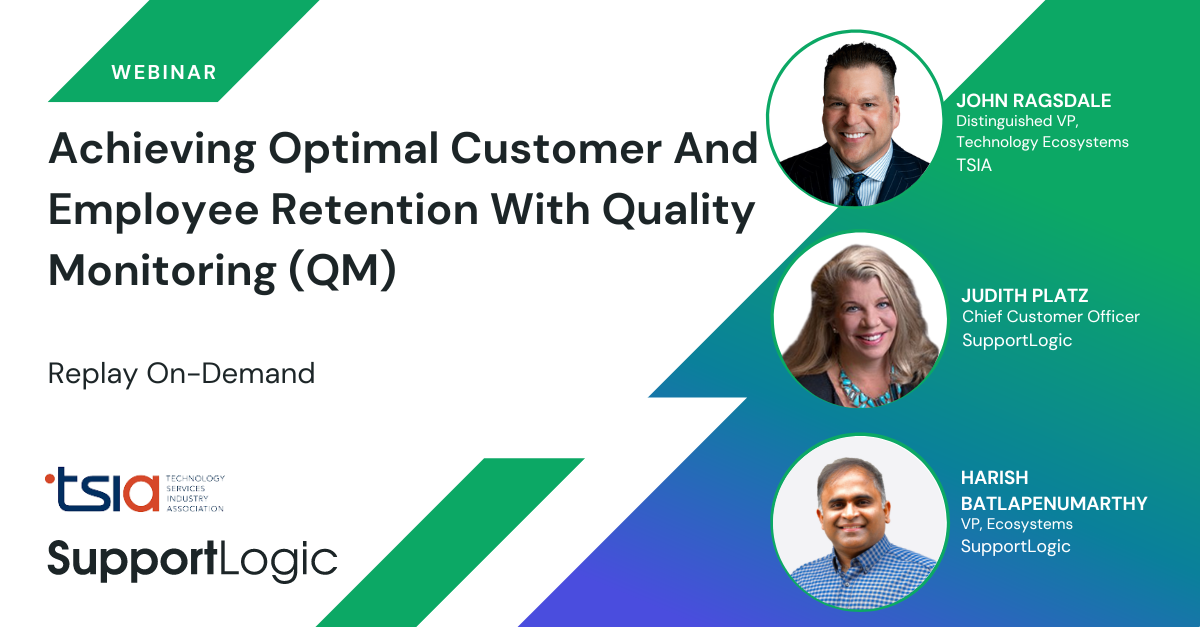
Aug 3, 2023
Improve Customer Loyalty and Retention with Automated Quality Monitoring
Support Quality Monitoring Toolsquality assurancequality monitoringagent coaching
Two out of three customers expect brands to understand their unique needs and desires. Businesses can’t afford to rely on guesswork or assumptions. They need to truly understand their customers and deliver personalized experiences that exceed expectations. But how can companies achieve this level of understanding and personalization? The answer lies in quality monitoring.
Quality monitoring for customer support systematically analyzes customer interactions to ensure a consistent and excellent support experience that meets and exceeds customer expectations. This process uncovers actionable insights into boosting agent performance and making every interaction a positive experience for your team and your customers.
By ensuring a valuable support experience, businesses will foster enjoyable customer interactions that drive greater customer loyalty and retention. This is especially crucial for SaaS companies where retaining existing customers is significantly more cost-effective than acquiring new customers. Today, we’ll cover some of the biggest challenges to improving customer loyalty and retention, along with several best practices for overcoming them.
3 common obstacles to customer loyalty and retention
Creating effective customer retention strategies starts with understanding the challenges customers face.
1. Limited visibility into customer interactions
Today, 80% of consumers report that they are more likely to buy from a brand that offers personalized experiences. Without a comprehensive view of customer interactions, businesses may miss crucial insights about their customers’ needs, preferences, and pain points. These insights are invaluable for tailoring the customer experience to meet and exceed customer expectations.
When businesses fail to understand their customers deeply, they risk delivering a generic or subpar customer experience, leading to fewer loyal customers and, ultimately, a higher customer churn rate.
2. Inconsistent customer experiences
Inconsistent experiences can be a significant roadblock in the customer journey. Data from Salesforce uncovered that 76% of customers expect a consistent experience, no matter which department they’re talking to. However, over 50% believe that support, sales, and marketing teams don’t even share information.
Customers want to feel recognized, understood, and valued. When this doesn’t happen, it can lead to a disjointed customer experience that can damage customer loyalty.
3. Subpar customer support
Gartner found that 96% of customers who expend much effort during a support interaction become more disloyal to a brand. The easier it is for customers to interact with your support team, the better their experience is, and the more likely they are to stay loyal to your brand.
However, if customers have to jump through hoops to get the help they need, it can lead to frustration and dissatisfaction, pushing them away from your brand.
Why automated quality monitoring is the solution
Compared to manual processes, automated quality monitoring analyzes 100% of support cases, providing a more accurate and impartial evaluation of the support experience.
Let’s review some other benefits of quality monitoring automation for your business.
More efficient support operations
Real-time feedback enables immediate corrective action rather than waiting for a weekly or monthly review. This real-time coaching can significantly improve agent performance and, by extension, the customer experience.
Automated quality monitoring can also increase customer feedback, which directly informs your agent coaching program. This customer data enables agents to complete higher training and certification 55% faster than if they only had feedback from manual quality monitoring processes.
More access to customer data for other departments
Quality monitoring also offers invaluable insights that can be shared with other departments to improve overall business outcomes. For instance, product and engineering teams can use these insights to develop features that customers really want and fix things that aren’t necessarily bugs but don’t work well.
Similarly, customer success and sales teams can better understand customer behavior, preferences, and expectations. With this information, they can better protect revenue by finding opportunities to expand the current customer base and evaluating overall customer health.
Greater cost savings and ROI
The return on investment (ROI) from quality monitoring can be substantial for the C-suite. Imagine the annual cost savings from:
- Right-sizing the quality team
- Lowering the average handle time
- Having fewer repeat calls due to poor service
- Providing fewer refunds due to the improved quality of your product or service
Not to mention the potential for revenue retention and growth due to higher brand loyalty. It’s a win-win situation for everyone, especially for finance folks who are always looking to improve net-dollar retention, margins, and customer lifetime value.
How to improve customer loyalty and retention with automated quality monitoring
Automated quality monitoring with innovative strategies and technology can be a game-changer in transforming the approach to customer support and increasing customer retention.
Go beyond tracking customer satisfaction
In the quest to improve customer loyalty and retention, businesses often focus on getting more satisfied customers. While this is undoubtedly important, it’s equally crucial to go beyond this and consider the customer’s effort.
The Customer Effort Score (CES) is a powerful metric that can provide insights into how easy it is for customers to interact with your business. This is important because there’s a strong correlation between CES and the Net Promoter Score (NPS), a key indicator of customer loyalty.
However, not all companies include CES in their quality monitoring. That’s because not everyone is familiar with CES and its significance compared to more commonly used metrics like CSAT and NPS.
Additionally, in an attempt to make services more accessible, businesses often push more onto customers, such as self-service options. While this may seem like a good idea, it can inadvertently increase the effort required from the customer’s side.
Consider a situation where a customer has a technical issue with a product. If they can easily find a solution through your support channels, they will likely feel positive about your brand. On the other hand, if they have to spend a lot of time searching for information or waiting for a response, they may become frustrated and think twice about continuing to do business with you.
By tracking CES and reducing customer effort, you can ensure that customers have a smooth and effortless experience, which can go a long way in improving their loyalty and retention.
Leverage AI-powered software to analyze interactions across all communication channels
In today’s digital age, customers interact with your business through a variety of channels, including email, phone, chat, and social media. This multi-channel approach provides convenience for customers, but it also presents a challenge for your organization: maintaining visibility into all these interactions. Limited visibility can lead to:
- Inconsistent customer experiences
- Missed opportunities for improvement
- Lower customer retention rate
This is where AI comes into play. Advanced AI technology, trained explicitly for customer support data, analyzes customer interactions across all channels to extra meaningful insights that inform your support experience.
For example, SupportLogic’s sentiment analysis platform monitors both voice and text interactions to predict when customers are unhappy and empower your team to deliver more proactive support.
Another significant advantage of using AI-powered software is that it provides real-time insights. Traditional manual quality monitoring often involves a delay as interactions are reviewed and scored weekly or monthly. With AI technology, you can get insights and course-correct almost immediately. This real-time feedback is invaluable for improving the customer experience before it’s too late and boosting customer loyalty and retention.
Be strategic rather than tactical
Quality monitoring has traditionally used a tactical approach, asking questions like how to boost productivity, close calls faster, or increase First Contact Resolution (FCR). But today, more companies are seeing the value of customer support data for their entire organization.
That’s because the support team often interacts with customers more than any other department in the enterprise. These interactions are a goldmine of information that can improve various aspects of your business.
However, to leverage these insights effectively, you need to shift your focus from purely tactical metrics to more strategic ones like sentiment analysis or escalation prediction. AI-powered software can analyze customer interactions across all channels, identify patterns, and provide predictive insights that can help you proactively address issues before they escalate.
For example, if a particular product feature consistently leads to confusion and support requests, this information can be relayed to the product team for improvement. Similarly, if a specific step in the onboarding process causes customer frustration, the customer success team can work on making that step more user-friendly.
By being strategic in your quality monitoring, you can enhance the support experience and drive improvements in other areas of the business, ultimately boosting customer loyalty and retention.
Take customer loyalty and retention to the next level with Auto QA
By understanding and implementing these strategies, you can transform customer support from a reactive problem-solving unit into a proactive, strategic contributor to the business’s overall success. This shift will lead to more efficient operations, improved customer experiences, and increased customer loyalty and retention.
To find out how to elevate your support experience with real-time insights into 100% of your customer interactions, learn more about Auto QA by SupportLogic.
Don’t miss out
Want the latest B2B Support, AI and ML blogs delivered straight to your inbox?


